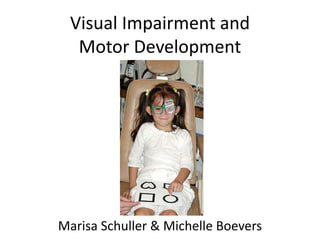
Visual Impairment and Motor Development
- 1. Visual Impairment and Motor Development Marisa Schuller & Michelle Boevers
- 2. Visual Impairments •Definition: A vision impairment which, even when corrected, causes negative effects on student’s educational performance. •There is a range of severity of VI and it is very individualized. •Age range for this presentation 0-5 years. •Vision Video
- 3. Types of Vision Peripheral Field Loss Acuity Loss Cortical Visual Impairment (CVI)
- 4. Peripheral Field Loss “Refers to the activity of the six external muscles of the eye responsible for providing coordinated movements of the eyes. Orthoptic vision includes binocular vision (the ability of the eyes to coordinate), depth perception (including strabismus, amblyopia and alternating) and nystagmus (constant involuntary movement of the eyeballs).” (French, 2011).
- 5. Acuity Loss “The degree of detail that can be seen in an object. The product of light rays bending and reaching receptors (rods and cones) of the retina. Refraction is influenced by the size and shape of the eyeball which changes with age. Refractive vision includes myopia (nearsightedness), hyperopia (farsightedness) and astigmatism (blurring or distortion of the image).” (French, 2011).
- 6. Cortical Visual Impairment (CVI) “Cortical visual impairment (CVI) is a neurological disorder, which results in unique visual responses to people, educational materials, and to the environment. When students with these visual/behavioral characteristics are shown to have loss of acuity or judged by their performance to be visually impaired, they are considered to have CVI.” (Lantzy, 2011).
- 7. Indicators of Disability •Hesitant and overcautious walking. •Uncoordinated movement on even and uneven surfaces. •Walking down steps using a marked time pattern. •Lack of ability to track object. •Sensitive to normal lighting levels.
- 9. Impact on Gross Motor Development •Motor Development is delayed, especially in locomotion and mobility. However, most milestones are similar in early childhood development. Around age 3 is when differences start to be noted. Typically developing children will be working on object control skills, where children with VI are still working on locomotor movements.
- 10. Impact on Gross Motor Development •Degree of Visual Impairment, gender and age conversely effect fitness scores. •More severe Visual Impairment the lower physical fitness than sighted peers.
- 11. Impact on Fine Motor Development•Children with VI are delayed a few months from their non-disabled peers in most age sets. When they reach about 2 years, they are working on large objects (blocks, etc) while their peers are working with small objects (crayons).
- 12. Considerations •Ensure optimal lighting. •Classroom organization must be consistent and without stray items. •Put audio devices in equipment for tracking. •Use brightly colored equipment. •Wear eye protection for safety when necessary.
- 13. Sport Opportunities for VI •Alpine Skiing- Adapted downhill skiing is a team sport with a sighted guide directing someone with VI down a course. •Beep Baseball- A modified game of baseball which includes buzzing bases, a beeping ball and team competition. •Futsal- A reduced dimensional soccer type game, with sighted goalie. •Goalball- Strategic 3 on 3 game of throwing a
- 14. Classification for VI •Class B1 No light perception in either eye up to light perception, but inability to recognize the shape of a hand at any distance or in any direction. •Class B2 From ability to recognize the shape of a hand up to visual acuity of 20/600 and/or a visual field of less than 5 degrees in the best eye with the best practical eye correction. •Class B3 From visual acuity above 20/600 and up to visual acuity of 20/200 and/or a visual
- 15. Lesson Presented •Simulation Goggle Activity Stations Jumping Rope Volleying a Ball Dribbling a Basketball Locomotor Skills
- 16. Summary •Motor Development is delayed among individuals with VI, but is more noted after age 3. •Understand the type and severity of vision loss to better serve individuals with VI. •Consider the environment and task constraints when planning and implementing lessons for an individual with vision loss.
- 17. Sources Lantzy, C.R. (2011). American Printing House for the Blind: What is CVI? Retrieved from http://www.aph.org/cvi/define.html. Lieberman, L. (2009). Teaching Children with Visual Impairments [video file]. Retrieved from http://www.pecentral.org/mediacenter/video_tea chingvipart1.html and http://www.pecentral.org/mediacenter/vide o_teachingvipart2.html. Lucas, M. (2011). IBSA Visual Classifications.